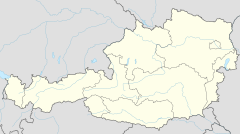Melk Abbey
| Melk Abbey | |
|---|---|
| Native name German: Stift Melk | |
 Melk Abbey | |
| Location | Austria |
| Coordinates | 48°13′41″N 15°20′02″E / 48.22806°N 15.33389°E |
| Area | Europe |
| Architect | Jakob Prandtauer |
| Architectural style(s) | Baroque |

Melk Abbey (
History
The abbey was founded in 1089 when Leopold II, Margrave of Austria gave one of his castles to Benedictine monks from Lambach Abbey. A monastic school, a forerunner of the Stiftsgymnasium Melk, was founded in the twelfth century, and the monastic library soon became renowned for its extensive manuscript collection and production, many of them contain musical compositions. In the fifteenth century the abbey became the centre of the Melk Reform movement which reinvigorated the monastic life of Austria and Southern Germany.[3]
Today's Baroque abbey was built between 1702 and 1736 to designs by Jakob Prandtauer. Particularly noteworthy are the abbey church with frescos by Johann Michael Rottmayr and Paul Troger.[4] In the later eighteenth century, Abbey of Melk became a center of Enlightenment thought and social exchange; there was even a Masonic lodge there, since a number of monks were Freemasons.[5]
Due to its fame and academic stature, Melk managed to escape dissolution under Emperor
Since 1625 the abbey has been a member of the Austrian Congregation, now within the Benedictine Confederation.
In his novel The Name of the Rose, Umberto Eco named one of the medieval protagonists "Adso of Melk" as a tribute to the famous abbey. Melk Abbey is also the metaphorical climax ("a peak in a mountain range of discovery") of Patrick Leigh Fermor's autobiographical account of his walking tour across Europe in A Time of Gifts.[7]
The abbey is part of
Restoration efforts
The first fire at Melk Abbey and its invaluable library was in 1297. This left the structures destroyed.[8] Most of the manuscripts Melk is famous for housing were saved by monks. During the 1683 Turkish invasion, the Melk Abbey also suffered severe damages.[9]
The abbey that stands today, built in 1702, caught fire in 1974. This fire marred the ornamented rooms and damaged the interior and its art, [10] leading to its restoration from 1978 to 1995. [8] The nave of the abbey was a part of the restoration. Eight pounds of gold bullion were used to restore the statues and altars. The Marble Hall, a popular guest attraction, was also restored during this period.[10]
In July 2019, Christine Glaßner, from the Austrian Academy of Sciences' Institute of Medieval Research, while researching the abbey's archives, discovered a previously unknown strip of parchment that bears 60 partial lines of the poem Der Rosendorn, what commentators called the first Vagina Monologues. The parchment, which had been subsequently recycled into the binding of a much later book, has been dated to around 1300; this is nearly 200 years earlier than it was previously thought to have been written.[11]
Euro commemorative coin

Melk Abbey was selected as the main motif of a 10 euro collectors' coin: the Austrian Melk Abbey commemorative coin, minted on April 18, 2007. The obverse shows a view up to the façade of the abbey church and its two side wings from a low level. The twin baroque towers and the great dome of the church behind them can be seen. In the lower right corner the coat-of-arms of the Abbey of Melk (the crossed keys of St. Peter) can be seen.[12]
Gallery
-
West view of Melk Abbey
-
North side of Melk Abbey and entry of Melk river into the Danube
-
View from the south
-
Main entrance
-
Prelate's courtyard
-
Melk Abbey at night
-
Melk Abbey at night from the old town
-
Aerial view
-
Leopold Altar, painting by Georg Bachman (1650)
-
Choir stalls
-
Pulpit
-
The ceiling
-
Staircase between the library and church
-
Church of the Abbey
-
Frescoed ceiling of the church
-
Cupola of the church
-
The Triumph of the Monk, by Johann Michael Rottmayr
-
Melk Abbey
-
Melk Abbey
-
Margravine Swanhilde's altar, eleventh century
-
St. Benedict's triumphal ascent to Heaven, also by Rottmayr
-
Painting on the ceiling of the marble hall
-
Melk Abbey in 1672, before its renovation by Jakob Prandtauer.
References
- ^ "Melk, Niederösterreich". Encyclopedia of Austria. Retrieved 8 January 2013.
- ASIN B000N48KHS.
- ^ Toke, L. (1911). "Abbey and Congregation of Melk". The Catholic Encyclopedia. New York: Robert Appleton Company. Retrieved 8 January 2013.
- ^ Weninger, Peter, ed. (1964). Ausstellung Paul Troger und die österreichische Barockkunst.
- ^ Kontler, László. "Report on the Habilitation request of Dr. Ulrich L. Lehner" (PDF). Central European University. Archived from the original (PDF) on December 2, 2023. Retrieved December 2, 2023.
- ^ Trotter, Henry (1911). . In Chisholm, Hugh (ed.). Encyclopædia Britannica. Vol. 7 (11th ed.). Cambridge University Press. pp. 819–823, see page 820, para 3.
The Danube between Linz and Vienna is renowned for its picturesque beauty and the numerous medieval and modern buildings of historical and archaeological interest which crown its banks. The splendid Benedictine monastery of Melk ....[is] among the most interesting.
- ^ Fermor, Patrick Leigh (2005). A Time of Gifts: On Foot to Constantinople. New York, pp. 172–77.
- ^ a b Kummer, E. (2003), "Melk, Abbey of", New Catholic Encyclopedia, vol. 2nd ed, Gale, pp. 478–479
- ^ Gordan, Lucy. "Melk Abbey-A Microcosm of Austrian History". German Life. 16 (1): 44–47.
- ^ a b Lewis, Paul (Jan 12, 1986). "An Abbey's Grandeur Restored in Austria: At Melk, lavish baroque ornamentation is refurbished". New York Times: 19, 34.
- ^ Connolly, K. (2019). "Medievalists Excited at Parchment Fragment of 'Vagina Monologue'". The Guardian. Archived from the original on 27 July 2019. Retrieved 28 July 2019.
- ^ 2012 Standard Catalog of World Coins 2001 to Date. 2011.

























